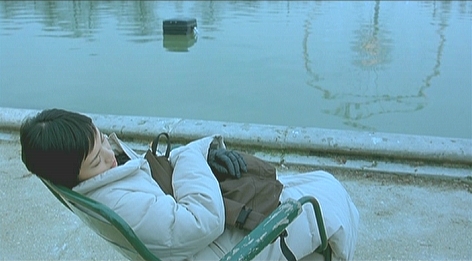
Many of the films of Paul Thomas Anderson are like the characters in Shakespeare plays; they have one fatal flaw. In Punch-Drunk Love, his first and only full blown romantic comedy to date, real human emotion is too often subverted in the interest of all things quirky. With what was called a shockingly serious performance, Adam Sandler plays a nervous and impulsive small businessman who gets himself into trouble when he hands his credit card over to an erotic phone chat company. To me, Sandler plays his normal fidgety self, the one strength being that there is a pinch of him not thinking he's most the most hilarious human on the planet. His character Barry Egan can actually be analyzed as a socially awkward twitch rather than a self-inflated maniac. On an average day, a peculiarly named girl Lena Leonard stumbles upon Barry's workplace and he is struck with affection. Beforehand, he acquires a harmonium off the side of the street, which Anderson strains to connect to the plot, but ends up only portraying a pathetic guy's attachment to the random beeping of notes. By the end, as if by some stroke of miracle, he plays a chord.
This is all meant to be funny I suppose, but Anderson builds each joke up too anxiously with the help of Jon Brion's obtrusive score. The ticking percussion serves its purpose literally; when the tick stops, an awkward characterization springs up and then it starts back up again. The music is absent however for the most baffling line of the film when Lena whispers to Barry, "I wanna chew off the skin on your face." Punch-Drunk Love is overflowing with quirks. Anderson's directorial style in the film is at times admirable but his hope of impressing art film fans feels too self-conscious. There are useless tidbits of tye-dye animations that interrupt the viewing experience once in a while; they seem like a way of affirming that "yes, this is indeed a romantic comedy and is intended to be very flowery despite the frequent spurts of anger." I couldn't make much sense of their true purpose.
The visual style is beautiful and quite Kubrickian, like Anderson has displayed in much of his work, but he fetishizes it to the point of self-indulgence. In the scene where Barry first notices the harmonium on the road, a shot that relishes the grandeur of the long street is on screen. Then Anderson reverses this shot to look the opposite way. As if that wasn't overkill, he then proceeds to show two more wonderful depth of field shots. One of these images for a prolonged amount of time would have worked better for the action that follows the pensive silence. Although Punch-Drunk Love charms frequently and is pretty engaging (something I've left out), Anderson's gimmicks shine through far too much. The film is a declaration to the fact that Anderson matured in a shortage of time to create his masterpiece There Will be Blood.






